#flipspaces
Text
What is the psychological impact of office interior branding on employee morale?
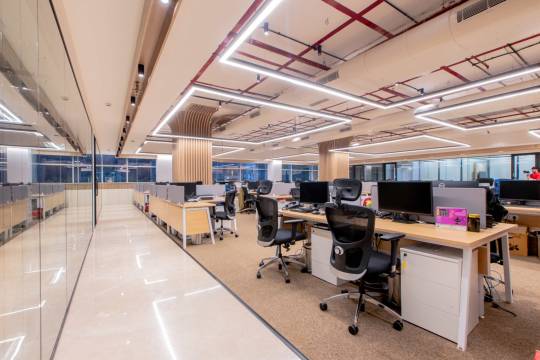
Office interior branding is more than just decorating the workspace. It's a deliberate strategy to shape the psychological and emotional experience of employees within the office environment. The way an office is designed and branded can significantly impact employee morale and, consequently, their productivity, creativity, and overall well-being.
Creating a Positive Work Environment
One of the fundamental aspects of office interior branding is creating a positive work environment. The choice of colors, layout, lighting, and furniture can influence how employees feel when they enter the office each day. Bright and vibrant colors can evoke a sense of energy and enthusiasm while calming colors like blues and greens can create a more relaxed and focused atmosphere. A well-branded office incorporates the company's colors and themes, reinforcing the organizational identity and reminding employees of the company's values and mission.
Fostering a Sense of Belonging
Office interior branding is a tool for fostering a sense of belonging and ownership among employees. When employees see the company's branding elements integrated into the office design, they feel a connection to the organization. It creates a sense of pride in being part of the company, which can significantly boost morale. The branding elements act as constant reminders of the collective goals and achievements, instilling a sense of unity and purpose among the team.
Enhancing Employee Engagement and Productivity
A well-branded office can enhance employee engagement and productivity by creating a stimulating and organized work environment. Thoughtful branding can guide employees through the office space, improving navigation and reducing the feeling of being lost in a vast, uninspiring office. Clear signage, branded meeting rooms, and strategically placed motivational quotes can provide a sense of direction and purpose, helping employees stay focused and motivated throughout the day.
Promoting a Healthy Work-Life Balance
Office interior branding can also contribute to promoting a healthy work-life balance, which is crucial for maintaining high employee morale. Incorporating spaces for relaxation, wellness, and social interactions within the office can alleviate stress and boost morale. A branded break area or lounge with comfortable furniture, plants, and calming colors can provide employees with a retreat where they can recharge and unwind, ultimately enhancing their overall well-being and satisfaction.
Encouraging Creativity and Innovation
A creatively designed office space can spark creativity and innovation among employees. Thoughtful branding that reflects the company's innovative spirit can inspire employees to think outside the box and come up with fresh ideas. Incorporating unique and inspiring design elements, artistic displays, and interactive spaces can create an environment that encourages creativity and stimulates the imagination, leading to higher morale and job satisfaction.
In conclusion, office interior branding goes beyond aesthetics; it has a profound psychological impact on employee morale. A well-branded office can shape a positive work environment, foster a sense of belonging, enhance engagement and productivity, promote a healthy work-life balance, and encourage creativity and innovation. Organizations should invest in thoughtful office branding to create a workspace that not only reflects their brand identity but also uplifts and motivates their most valuable asset—their employees. You can get your next office interior branding designed and built by a tech-led interior design company such as Flipspaces which can be your one-stop solution to all your turnkey needs.
0 notes
Text
What is a suggested restaurant interior for Izakayas?
Title: Crafting the Perfect Ambiance: Restaurant Interior Design for Izakaya's
Introduction
Izakaya's, traditional Japanese pubs, have gained immense popularity worldwide for their unique blend of delicious cuisine, relaxed atmosphere, and carefully crafted interior designs. These cozy establishments offer a glimpse into Japanese culture, combining elements of traditional and contemporary design to create a warm and inviting environment for patrons. In this blog, we will explore the key elements that make up the perfect restaurant interior for Izakaya's.

Warm and Earthy Colors
One of the first things you'll notice when stepping into an Izakaya is its warm and earthy color palette. This choice of colors is intentional, as it creates a soothing and comfortable atmosphere. Earth tones like deep browns, warm grays, and muted greens are often used on the walls, floors, and furniture. These colors help patrons feel at ease and encourage them to linger, enjoy their meals, and engage in conversation.
Natural Materials
Izakaya's often incorporate natural materials like wood and stone into their interior design. Wooden beams, tables, and chairs provide a rustic and cozy feel, while stone accents on walls or as part of the bar area add an element of authenticity. These materials not only enhance the aesthetic but also connect patrons with the essence of Japanese culture, where a deep appreciation for nature is prevalent.
Intimate Seating Arrangements
The seating arrangement in an Izakaya is crucial in creating an intimate and social dining experience. Low tables with floor cushions, known as zashiki, are a common choice, allowing patrons to sit close to the floor and engage in conversation comfortably. This arrangement promotes a sense of togetherness and camaraderie among diners, which is a hallmark of the Izakaya experience.
Soft Lighting
The lighting in an Izakaya is carefully designed to set the mood. Soft, warm lighting is preferred over harsh, bright lights. Paper lanterns, pendant lights, and candlelit tables are common fixtures. These not only create a cozy ambiance but also add a touch of romance and intrigue to the space.
Traditional Japanese Art and Décor
To reinforce the Japanese aesthetic, Izakaya's often feature traditional Japanese art and décor. This may include calligraphy, painted screens, or even sake barrels displayed prominently. These elements provide a sense of cultural immersion and authenticity, transporting diners to Japan without leaving their seats.
Open Kitchen Concept
Many Izakaya's incorporate an open kitchen concept, allowing patrons to watch as skilled chefs prepare their meals. This not only adds an element of transparency and trust but also contributes to the sensory experience, as the sights and smells of food being prepared become part of the overall ambiance.
Soundscapes and Music
Sound plays a vital role in creating the right atmosphere in an Izakaya. Soft, traditional Japanese music or ambient sounds like flowing water are often used to enhance the dining experience. The goal is to create a tranquil environment where patrons can relax and enjoy their meal without feeling rushed.
Conclusion
Designing the interior of a restaurant chain requires careful planning and consideration. It's an opportunity to express your brand's identity, create a memorable dining experience, and ensure consistency across multiple locations. By paying attention to key elements like brand identity, layout, lighting, furniture, color palette, décor, music, and sustainability, you can create an inviting and cohesive restaurant interior that keeps customers coming back for more. Remember, the interior of your restaurant is an integral part of your brand story, so make it count. One can achieve this by getting in touch with renowned design and build firms such as Flipspaces, which can help you with the same.
0 notes
Text
What are the future prospects and innovations we can expect to see in the world of modern hotel design?
Title: The Future of Modern Hotel Design: Innovations and Prospects
Introduction
The world of modern hotel design is constantly evolving, driven by changing consumer preferences, technological advancements, and a growing emphasis on sustainability and wellness. As we look ahead, the future prospects and innovations in hotel design promise to redefine the guest experience, making it more personalized, sustainable, and technologically integrated than ever before. In this blog, we'll explore some of the exciting developments and trends that are shaping the future of hotel design.
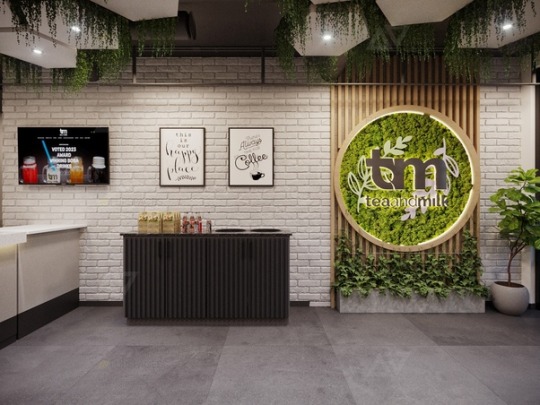
Sustainable Architecture and Design
In an era of increasing environmental awareness, sustainable hotel design is at the forefront of innovation. Architects and designers are incorporating eco-friendly materials, energy-efficient systems, and green technologies into hotel construction. Living walls, solar panels, rainwater harvesting, and intelligent climate control systems are becoming standard features in many hotels, reducing their carbon footprint while enhancing guest comfort.
Biophilic Design
Biophilic design, which emphasizes the connection between humans and nature, is gaining traction in the hotel industry. Expect to see more hotels incorporating natural elements such as indoor gardens, water features, and sustainable wood materials. These elements not only create a calming and rejuvenating atmosphere but also contribute to guests' well-being.
Smart Rooms and IoT Integration
The integration of the Internet of Things (IoT) is transforming hotel rooms into smart, connected spaces. Guests can control lighting, temperature, and entertainment systems through their smartphones or voice commands. Additionally, IoT sensors can provide personalized experiences, such as adjusting room settings based on individual preferences and tracking guests' needs in real time.
Contactless Technology
The COVID-19 pandemic accelerated the adoption of contactless technology in hotels. Mobile check-in and check-out, keyless room entry, and digital concierge services have become the new norm. These innovations not only enhance guest safety but also streamline the guest experience.
Personalized Experiences
Guests are seeking unique and personalized experiences when they stay at hotels. Hoteliers are responding by designing spaces that cater to individual preferences, offering curated amenities and services, and leveraging data analytics to anticipate guest needs. Personalization is becoming a cornerstone of modern hotel design.
Multifunctional Spaces
Modern hotels are reimagining their public spaces to be more versatile and adaptable. Many are incorporating co-working areas, event spaces, and hybrid dining options to cater to both business and leisure travelers. This flexibility allows hotels to maximize their use of space and appeal to a wider range of guests.
Art and Culture Integration
Art and culture play a significant role in shaping the identity of modern hotels. Many hotels are partnering with local artists and curators to display artwork throughout their properties, creating a unique and immersive experience for guests. This cultural integration adds depth and character to the hotel's design.
Wellness-Oriented Design
Wellness is a growing trend in hotel design. Expect to see more emphasis on fitness facilities, spa amenities, and wellness-focused room features like air purification systems, circadian lighting, and ergonomic furniture. Hotels are increasingly becoming places where guests can relax, rejuvenate, and prioritize their well-being.
Virtual Reality (VR) and Augmented Reality (AR)
The use of VR and AR technologies is on the rise in the hotel industry. These technologies can be used to showcase room designs, offer virtual tours of the property, and provide immersive experiences that enhance guest engagement. VR and AR have the potential to revolutionize how guests interact with hotel spaces.
Conclusion
The future of modern hotel design is marked by sustainability, technology integration, personalization, and a commitment to well-being. As travelers' expectations continue to evolve, hotels are embracing innovation to stay competitive and offer memorable experiences. From sustainable architecture to personalized smart rooms, the future of hotel design promises to be an exciting blend of aesthetics, functionality, and guest-centricity. As hotel designers continue to push boundaries and explore new possibilities, guests can look forward to a more enriching and immersive hospitality experience. You can get your next modern hotel design designed and built by a tech-led interior design company such as Flipspaces which can be your one-stop solution to all your turnkey needs.
1 note
·
View note
Text
Should you prioritize durability or aesthetics in restaurant wall design?

The Significance of Durability:
Durability is a critical consideration in restaurant wall design for several reasons:
High-Traffic Areas: Restaurant walls are exposed to continuous wear and tear, especially in high-traffic areas. Patrons, staff, and delivery personnel constantly brush against walls, which can lead to scuffs, scratches, and damage.
Cleaning and Maintenance: Restaurant walls must be easy to clean and maintain, as they are susceptible to spills, stains, and splatters. Walls that can be wiped clean without causing damage or discoloration are essential for a hygienic and appealing environment.
Longevity and Cost-Efficiency: Investing in durable materials and finishes for restaurant walls can lead to cost-efficiency in the long run. Frequent repairs and replacements of damaged walls can be expensive and disruptive to the restaurant’s operation.
Safety and Compliance: Wall materials must meet safety and compliance standards. Fire-resistant, non-toxic, and non-flammable materials may be required in certain areas of the restaurant, such as the kitchen or near heating equipment.
Structural Integrity: The durability of restaurant walls also impacts the structural integrity of the space. Walls must provide adequate support, especially in load-bearing areas or when they are part of the building’s structure.
The Role of Aesthetics:
While durability is crucial, aesthetics also play a pivotal role in restaurant wall design:
Atmosphere and Branding: Aesthetics set the tone for the restaurant’s atmosphere and branding. The interior design, including the walls, should align with the restaurant’s concept and theme. The right aesthetics can enhance the overall dining experience and leave a lasting impression on customers.
Guest Comfort and Satisfaction: Visually appealing restaurant walls contribute to guest comfort and satisfaction. A well-designed interior can create a welcoming and enjoyable ambiance, encouraging patrons to return and recommend the restaurant to others.
Competitive Edge: In a competitive industry, aesthetics can give a restaurant a competitive edge. Unique and visually striking wall designs can help a restaurant stand out and attract a diverse clientele.
Balancing Durability and Aesthetics:
The key to successful restaurant wall design is finding the balance between durability and aesthetics:
Choose Suitable Materials: Select wall materials that offer a blend of both durability and aesthetic appeal. For example, consider durable paint finishes that are easy to clean and come in a variety of colors and textures.
Prioritize High-Traffic Areas: Give priority to durability in high-traffic areas such as entrances, corridors, and bathrooms. Use materials that can withstand constant use and abuse while maintaining a cohesive design.
Accent Walls and Design Features: Allocate more attention to aesthetics in areas where durability is less critical, such as dining spaces. Create accent walls or design features that draw attention and contribute to the restaurant’s theme and atmosphere.
.Regular Maintenance: Implement a regular maintenance schedule to ensure that both the durability and aesthetics of restaurant walls are preserved. Promptly address any wear and tear issues to prevent more extensive damage.
Consult with Design Professionals: Consider working with design professionals who specialize in restaurant interiors. They can help you choose materials, finishes, and design elements that strike the right balance between durability and aesthetics.
In conclusion, the debate between durability and aesthetics in restaurant wall design is not an “either-or” scenario but rather a “both-and” approach. Both aspects are essential for creating a successful and inviting restaurant interior. By selecting suitable materials, prioritizing high-traffic areas, and carefully planning design features, you can achieve a harmonious equilibrium that ensures your restaurant walls withstand the test of time while providing a visually appealing and welcoming environment for diners. One can achieve this by getting in touch with renowned design and build firms such as Flipspaces, who can help you with the same.
0 notes
Text
What is a restaurant wall design for family-friendly establishments?
When it comes to family-friendly restaurants, the right wall design can have a significant impact on the overall dining experience. Family diners often seek an inviting and comfortable atmosphere that caters to both adults and children. In this blog, we'll explore how to design restaurant walls that enhance the family-friendly ambiance while maintaining a stylish and appealing space.

Bright and cheery Colors: Color plays a vital role in setting the tone for a family-friendly restaurant. Opt for bright and cheerful colors that create a welcoming and lively environment. Shades of warm yellows, soft blues, and vibrant greens can evoke a sense of happiness and relaxation, making families feel right at home.
Whimsical Wall Murals: Consider incorporating whimsical wall murals that appeal to both children and adults. These murals can depict playful scenes, underwater adventures, or vibrant landscapes. Murals can serve as a captivating focal point, sparking the imagination of young diners while adding visual interest to the space.
Interactive Wall Art: Interactive wall art installations can be a hit with families. Install magnetic walls or chalkboard-painted walls where children can draw, play games, or engage in creative activities while waiting for their meals. This not only keeps kids entertained but also adds an interactive element to the restaurant.
Kid-Friendly Themes: Choose restaurant wall design themes that resonate with children's interests. Whether it's a space-themed restaurant with cosmic wall decals or a jungle-themed eatery with lush foliage patterns, thematic design elements can enhance the dining experience for young patrons.
Family Photo Galleries: Consider dedicating a section of your restaurant walls to family photo galleries. Display photographs of happy families enjoying their meals at your establishment. This personal touch not only adds warmth but also encourages families to create memories at your restaurant.
Flexible Seating Options: Design restaurant walls to accommodate flexible seating arrangements suitable for families. Consider booths with high backs or wall-mounted bench seating that provides comfort and privacy. These seating options can also help control noise levels, creating a more pleasant dining environment.
Child-Friendly Height: Incorporate child-friendly design elements by adjusting the height of some wall-mounted features. For instance, a low chalkboard wall or a display shelf within reach of young children can make them feel more involved and engaged in the dining experience.
Safe and Easy-to-Clean Materials: Choose wall materials that are safe and easy to clean. Families with young children often mean spills and messes. Washable and durable materials, such as wipeable paint or washable wallpapers, can make maintenance a breeze while ensuring a family-friendly environment.
Family Dining Nooks: Create family dining nooks by designing cozy corners with booth seating, comfortable cushions, and child-sized tables. These nooks can offer privacy and a sense of togetherness for families, making dining a more intimate and enjoyable experience.
Incorporate Kid's Artwork: To further engage young diners, consider featuring artwork created by children in the restaurant's design. Showcase drawings, paintings, or crafts made by young artists in the community. This not only adds a personal touch but also celebrates the creativity of children.
In conclusion, designing restaurant walls for family-friendly establishments requires a thoughtful approach that balances aesthetics with functionality. By incorporating bright colors, whimsical murals, interactive elements, and child-friendly design features, you can create an inviting and enjoyable atmosphere for families. Remember that a family-friendly restaurant is not only about catering to children but also ensuring that parents and caregivers feel comfortable and relaxed during their dining experience. One can achieve this by getting in touch with renowned design and build firms such as Flipspaces, who can help you with the same.
0 notes
Text
What is the role of technology in modern office interior design?
In recent years, technology has become an integral part of modern office interior design. The incorporation of technology has transformed traditional office spaces into dynamic, productive, and interactive workplaces. Technology has revolutionized the way we work, communicate and collaborate, and it has had a significant impact on office interior design.
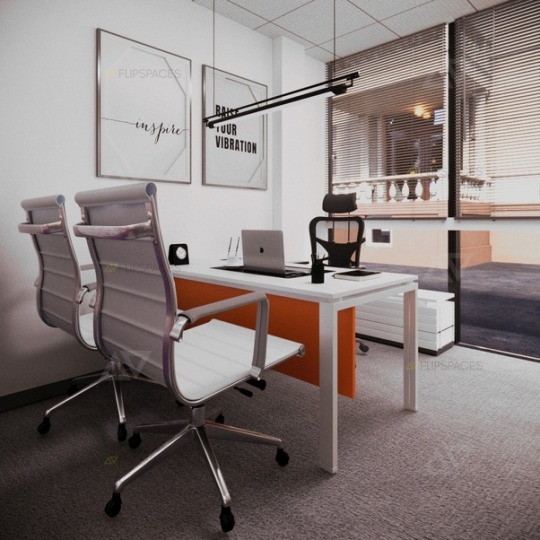
One of the major benefits of technology in office interior design is the increased flexibility and mobility it provides. With the use of mobile devices, cloud computing, and wireless technology, employees can work from anywhere, at any time. This has led to the emergence of flexible office spaces that are designed to accommodate different work styles and preferences. For instance, hot desking, which involves the use of unassigned workstations, has become popular in modern office interior design, enabling employees to work from any location within the office.
Another key role of technology in modern office interior design is the creation of interactive workspaces that facilitate collaboration and teamwork. For example, interactive whiteboards, video conferencing systems, and project management software enable teams to work together seamlessly, regardless of their location. This has led to the emergence of collaborative workspaces that are designed to promote teamwork and knowledge sharing.
Technology has also had a significant impact on the design and layout of modern office spaces. For instance, the use of digital signage and wayfinding systems can help employees navigate large office buildings and locate meeting rooms, break areas, and other facilities easily. Moreover, smart lighting and temperature control systems can enhance employee comfort and productivity, while also reducing energy consumption.
Another aspect of modern office interior design that has been impacted by technology is sustainability. Green technology, such as solar panels, LED lighting, and energy-efficient HVAC systems, can help reduce energy consumption, lower costs, and minimize the environmental impact of office spaces. This has led to the emergence of sustainable office design practices that prioritize energy efficiency and environmental responsibility.
Finally, technology has had a significant impact on the aesthetic appeal of modern office spaces. For instance, the use of digital art installations, interactive displays, and immersive environments can create visually stimulating and engaging workspaces that inspire creativity and productivity. Moreover, the use of modular furniture and wall systems allows for easy reconfiguration and customization of office spaces, enabling organizations to create unique and visually appealing work environments.
In conclusion, technology plays a crucial role in modern office interior design. From flexible workspaces to collaborative environments, sustainable design practices to aesthetic appeal, technology has transformed the way we design, build and use office spaces. By leveraging technology in office design, organizations can create dynamic, engaging, and productive work environments that promote innovation, creativity, and collaboration. One can achieve this by getting in touch with renowned design and build firms such as Flipspaces, who can help you with the same.
0 notes
Text
How can modern office interior design improve communication within a team?
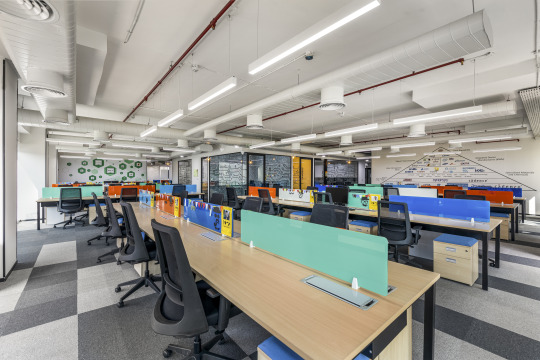
In today's fast-paced business world, effective communication within a team is critical for success. It is no secret that the layout and design of an office can greatly impact communication between team members. This is where modern office interior design comes into play, as it can improve communication within a team by creating an environment that fosters collaboration, creativity, and productivity.
One of the main ways modern office interior design can improve communication within a team is through open-plan layouts. Open-plan layouts allow team members to interact and communicate more freely, as there are no walls or barriers that can hinder communication. This layout encourages spontaneous communication and helps team members to form stronger relationships, which can lead to better collaboration and teamwork. Modern office interior design keywords that relate to open-plan layouts include "collaborative spaces," "flexible layouts," and "open spaces."
Another important aspect of modern office interior design that can improve communication within a team is the use of natural light. Natural light has been shown to improve mood and increase productivity, which can lead to better communication between team members. Modern office interior design keywords that relate to natural light include "large windows," "skylights," and "natural lighting."
The use of color is another important aspect of modern office interior design that can improve communication within a team. Colors can have a significant impact on mood and emotions, which can affect communication. For example, warm colors such as red and orange can increase energy and enthusiasm, while cool colors such as blue and green can promote calmness and relaxation. Modern office interior design keywords that relate to color include "color schemes," "accent walls," and "color psychology."
In addition to open-plan layouts, natural light, and color, modern office interior design can also improve communication within a team by incorporating technology. Technology such as video conferencing and interactive whiteboards can make communication more efficient and effective. Modern office interior design keywords that relate to technology include "smart offices," "interactive displays," and "collaboration tools."
Lastly, modern office interior design can improve communication within a team by creating comfortable and ergonomic workspaces. Comfortable and ergonomic workspaces can reduce distractions and physical discomfort, which can improve focus and concentration.
In conclusion, modern office interior design can greatly improve communication within a team by creating an environment that fosters collaboration, creativity, and productivity. By using open-plan layouts, natural light, color, technology, and comfortable and ergonomic workspaces, modern office interior designers such as Flipspaces can help team members communicate more effectively and efficiently. Incorporating these design elements can lead to better communication, improved teamwork, and ultimately, greater success for the business.
0 notes
Text
What are the key elements of modern office interior design in Mumbai?
Title: Unveiling the Essential Elements of Modern Office Interior Design Mumbai
In the dynamic landscape of Mumbai's corporate world, the design of office interiors plays a pivotal role in shaping productivity, employee satisfaction, and brand identity. With the city's rapid growth and diverse business landscape, modern office interior design Mumbai has evolved to encompass a unique blend of functionality, aesthetics, and cultural influences. Let's delve into the key elements that define contemporary office interiors in the bustling metropolis of Mumbai.
1. Space Optimization and Flexibility
In a city where every square foot counts, space optimization is paramount. Modern office interior design Mumbai emphasizes flexible layouts and multipurpose spaces to maximize efficiency and accommodate diverse work styles. From open-plan workstations to modular furniture and versatile meeting areas, flexibility is key to creating adaptable work environments that can evolve with the changing needs of businesses.
2. Incorporation of Technology
As a hub of technological innovation, Mumbai's modern office interiors are equipped with the latest advancements to enhance connectivity, collaboration, and productivity. From smart lighting and integrated AV systems to wireless charging stations and IoT-enabled devices, technology seamlessly integrates into the design to streamline workflows and foster innovation.
3. Biophilic Design and Sustainability
Amidst the urban hustle and bustle, modern office interiors in Mumbai strive to reconnect occupants with nature through biophilic design elements. Incorporating natural materials, indoor plants, and green spaces not only enhances aesthetics but also promotes well-being and productivity. Additionally, sustainable design practices such as energy-efficient lighting, recycled materials, and waste reduction initiatives are integral to creating environmentally conscious workspaces.
4. Ergonomic Furnishings and Wellness Initiatives
Employee health and wellness are top priorities in modern office interior design Mumbai. Ergonomic furnishings, adjustable workstations, and ergonomic seating options are implemented to enhance comfort and reduce the risk of musculoskeletal disorders. Wellness initiatives such as dedicated relaxation areas, meditation rooms, and fitness facilities contribute to a holistic approach to employee well-being, fostering a healthier and more balanced work environment.
5. Cultural Sensitivity and Brand Identity
Mumbai's vibrant cultural tapestry is reflected in the design of modern office interiors, where diversity and inclusivity are celebrated. Incorporating elements of local art, architecture, and heritage pays homage to the city's rich cultural heritage while reinforcing brand identity and values. Whether through vibrant color palettes, bespoke artwork, or traditional motifs, office interiors in Mumbai reflect the unique ethos and identity of each organization.
Conclusion
In conclusion, modern office interior design Mumbai is characterized by its emphasis on space optimization, technological integration, sustainability, employee wellness, and cultural sensitivity. By incorporating these key elements into the design, businesses can create dynamic, engaging, and productive workspaces that inspire creativity, foster collaboration, and support the well-being of their employees. As Mumbai continues to evolve as a global business hub, the importance of thoughtful and innovative office interior design will only continue to grow, shaping the future of work in the bustling metropolis. One can achieve these by getting in touch with the renowned design and build firm such as Flipspaces, who can help you with the same
0 notes
Text
What are the best materials for creating durable and stylish interior space designs?
Title: The Building Blocks of Timeless Elegance: Best Materials for Durable and Stylish Interior Space Designs
Introduction:
Crafting an interior space that seamlessly combines durability with style requires careful consideration of materials. The choice of materials not only influences the aesthetic appeal of a space but also determines its longevity and functionality. In this blog, we'll explore some of the best materials that strike the perfect balance between durability and style in interior space design, incorporating essential keywords to guide you in creating timeless and resilient environments.
Hardwood for Timeless Elegance:
Hardwood flooring and furniture are synonymous with classic elegance. Keywords like "timeless," "classic," and "natural beauty" underscore the enduring appeal of hardwood. Whether it's oak, maple, or walnut, hardwood adds warmth and sophistication to interior spaces while standing the test of time with its durability.
Versatile and Durable Ceramic Tiles:
Ceramic tiles are a versatile and durable choice, especially in high-traffic areas like kitchens and bathrooms. Using keywords such as "versatility," "resilience," and "easy maintenance" highlights the practical aspects of ceramic tiles. Their wide range of colors, patterns, and textures allows for creative expression without compromising on durability.
Stainless Steel for Modern Simplicity:
Stainless steel has become a staple in modern interior design, offering a sleek and minimalist aesthetic. Incorporate keywords like "contemporary," "sleek," and "industrial chic" to describe the modern simplicity that stainless steel brings to spaces. Its durability and resistance to corrosion make it an excellent choice for appliances, fixtures, and accent pieces.
Luxurious Natural Stone:
Natural stone, such as marble and granite, exudes luxury and sophistication. Keywords like "luxurious," "timeless beauty," and "durability" highlight the opulence associated with natural stone. Whether used for countertops, flooring, or accent walls, natural stone elevates the overall aesthetic while providing a durable and long-lasting surface.
Sturdy and Stylish Concrete:
Concrete has transcended its industrial origins to become a chic and durable interior material. Keywords like "modern," "industrial chic," and "sturdy" emphasize the versatility of concrete in contemporary design. From polished floors to statement countertops, concrete adds an urban edge to interior spaces while offering robust durability.
Durable Upholstery Fabrics:
When it comes to furniture and upholstery, selecting durable fabrics is crucial for longevity and style. Incorporate keywords such as "resilient," "stain-resistant," and "easy care" to highlight the importance of durable upholstery fabrics. Options like microfiber, leather, and performance fabrics provide both durability and style for furniture pieces.
High-Quality Laminate Flooring:
Laminate flooring has evolved to become a cost-effective and stylish alternative to hardwood. Keywords like "affordable elegance," "versatility," and "easy maintenance" showcase the benefits of laminate flooring. With realistic wood and stone textures, laminate offers a durable and budget-friendly solution for achieving a stylish interior.
Conclusion:
In the realm of interior space design, the selection of materials is a critical aspect that shapes the overall aesthetic and functionality of a space. By incorporating these durable and stylish materials, you can create interiors that stand the test of time while exuding timeless elegance. Whether you opt for the classic beauty of hardwood, the modern allure of stainless steel, or the luxurious appeal of natural stone, choosing the right materials is the key to achieving a harmonious blend of durability and style in interior design. One can achieve these by getting in touch with the renowned design and build firm such as Flipspaces, who can help you with the same.
0 notes
Text
Transforming Spaces: A Glimpse into Mumbai's Premier Interior Designers - Flipspaces
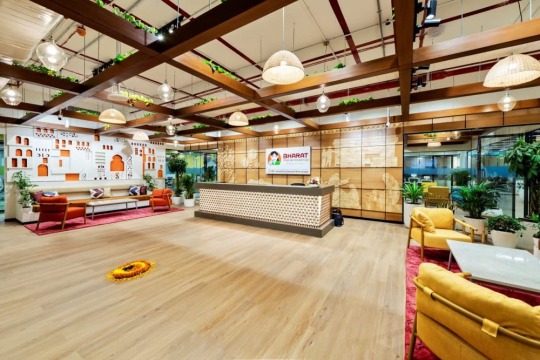
Interior designers in Mumbai
In the bustling metropolis of Mumbai, where innovation meets tradition, interior design plays a pivotal role in shaping the city's aesthetic landscape. Among the myriad of design firms, one name stands out for its groundbreaking approach and unparalleled creativity: Flipspaces. Let's delve into what makes Flipspaces the epitome of Interior designers in Mumbai.
With a vision to revolutionize the way spaces are designed, Flipspaces harnesses the power of technology to create immersive and transformative experiences. Their team of skilled designers, architects, and technologists collaborate seamlessly to craft spaces that are not just visually stunning but also highly functional.
At the heart of Flipspaces' philosophy lies the belief in the fusion of artistry and innovation. They embrace cutting-edge technologies such as virtual reality, augmented reality, and artificial intelligence to conceptualize and execute projects with utmost precision. This innovative approach allows clients to visualize their spaces in a lifelike manner before any construction begins, ensuring complete satisfaction and eliminating guesswork.
What sets Flipspaces apart is their relentless pursuit of perfection and attention to detail. Whether it's a luxurious residence, a corporate office, or a commercial establishment, each project is meticulously planned and executed to exceed client expectations. From concept development to final execution, Flipspaces ensures a seamless journey, marked by creativity, efficiency, and transparency.
Moreover, Flipspaces' commitment to sustainability and eco-conscious design sets them apart as pioneers in the industry. They prioritize the use of sustainable materials and practices, minimizing environmental impact while maximizing aesthetic appeal.
In a city known for its diversity and vibrancy, Flipspaces' designs reflect the eclectic spirit of Mumbai. Whether it's infusing traditional elements with contemporary flair or reimagining spaces with bold innovation, Flipspaces consistently delivers awe-inspiring designs that captivate and inspire.
In conclusion, Flipspaces stands as a beacon of creativity and innovation in Mumbai's interior design landscape. With their visionary approach, technological prowess, and unwavering commitment to excellence, they continue to redefine the boundaries of design, one space at a time.
0 notes
Text
How can businesses personalize their brand identity within a commercial space design in Hyderabad?
Title: Enhancing Brand Identity: Personalization in Commercial Space Design in Hyderabad
Introduction:
In the dynamic business landscape of space design Hyderabad, creating a distinct brand identity is crucial for standing out in a competitive market. One effective way to achieve this is through personalized commercial space design. This blog explores the strategies businesses can employ to personalize their brand identity within the commercial spaces they operate in.
Understanding Brand Identity:
Before delving into commercial space design Hyderabad , it is essential for businesses to have a clear understanding of their brand identity. This includes defining core values, mission, and target audience. Establishing a strong foundation allows for a cohesive and personalized design that resonates with the brand.
Consistent Visual Elements:
Personalizing brand identity within a commercial space involves incorporating consistent visual elements. This includes the use of brand colors, logos, and typography throughout the space. Consistency creates a memorable and unified brand image that reinforces the company's identity in the minds of customers and employees.
Customized Brand Signage:
Investing in customized brand signage is a powerful way to personalize commercial spaces. From exterior signage that catches the eye to interior signage that guides customers through the space, these elements serve as visual cues that reinforce brand identity. Ensuring clarity, simplicity, and alignment with the overall design theme are key considerations in this aspect.
Tailored Interior Design:
Personalizing brand identity extends beyond visual elements to encompass the overall interior design of a commercial space. This involves selecting furnishings, fixtures, and decor that align with the brand's personality. Whether it's a tech-savvy startup or a traditional business, the interior design should reflect the essence of the brand, creating a unique and memorable experience for visitors.
Incorporating Brand Storytelling:
Commercial spaces provide an excellent canvas for storytelling. Businesses can personalize their brand identity by integrating storytelling elements into the design. This could include wall graphics depicting the company's journey, achievements, or values. Storytelling fosters a deeper connection with customers and communicates the brand's narrative effectively.
Embracing Technology:
Incorporating cutting-edge technology into the commercial space design Hyderabad can further enhance brand personalization. Interactive displays, digital signage, and augmented reality experiences can create a modern and forward-thinking brand image. Ensuring that these technological elements seamlessly align with the brand's identity is paramount for a cohesive design.
Conclusion:
Businesses in Hyderabad can elevate their brand identity by strategically personalizing their commercial space designs. From consistent visual elements to tailored interior designs and innovative technology integration, the possibilities are vast. By prioritizing brand cohesiveness and creating a unique and memorable experience, businesses can establish a strong presence in the competitive market. Personalized commercial space design in Hyderabad not only attracts customers but also fosters a sense of identity and pride among employees, contributing to long-term success. One can achieve these by getting in touch with the renowned design and build firm such as Flipspaces, who can help you with the same.
0 notes
Text
Is office interior branding more than just decorating the workspace?
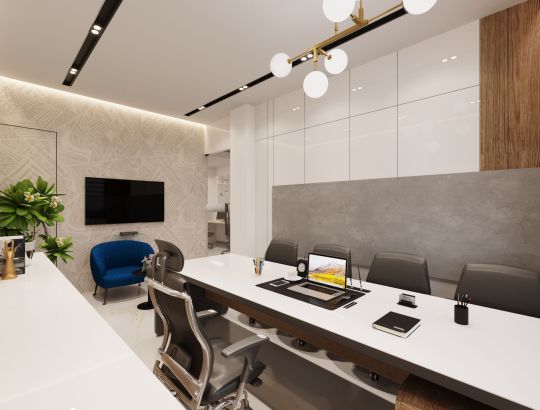
In the dynamic and competitive world of business, where first impressions and brand image play a significant role, the workspace is no longer just a place where employees work. It has become a canvas for expressing the values, culture, and identity of a company. Office interior branding goes beyond mere decoration; it's a strategic tool that communicates a company's essence and influences how both employees and clients perceive the organization.
A Symphony of Identity and Culture
Office interior branding involves orchestrating an environment that reflects the brand's identity and culture. Just as a symphony harmonizes various musical elements to create a pleasing melody, office branding orchestrates various design elements to create a cohesive and immersive experience for everyone who steps into the workspace. From color schemes to furniture design, every element is carefully chosen to align with the brand's message and values.
Communicating Corporate Identity
When you step into a well-branded office, you should instantly grasp the organization's values, mission, and brand personality. The interior design should embody the essence of the company, whether it's innovation, professionalism, creativity, or sustainability. Elements such as logos, colors, and branding materials strategically placed within the workspace serve as silent communicators, telling a story about the company to anyone who interacts with the space.
Influencing Employee Experience and Productivity
An environment that reflects a company's brand identity can significantly impact employees. When employees feel connected to the workspace, they are more likely to resonate with the company's mission and values. A thoughtfully branded office can boost morale, improve productivity, and foster a sense of pride and ownership among employees. It transforms the office into a place where employees don't just work, but feel a sense of belonging and alignment with the organizational objectives.
Creating a Lasting Impression on Clients and Visitors
For clients and visitors, the office serves as a window into the company's character and values. A well-branded office leaves a lasting impression, showcasing professionalism and attention to detail. It can influence their perception of the company's credibility, reliability, and dedication to its brand promise. It sets the stage for business interactions, instilling confidence and trust in the company.
The Marriage of Functionality and Aesthetics
Office interior branding isn't only about aesthetics. It's about merging form and function seamlessly. The design must not only embody the brand's identity but also optimize the workspace for efficiency and productivity. A well-branded office finds the perfect balance between showcasing the brand and providing a comfortable and functional environment for employees.
In Conclusion
Office interior branding is a strategic tool that transcends mere decoration. It's a vital aspect of a company's identity, culture, and overall perception in the market. When thoughtfully executed, it can transform a workspace into a powerful representation of the brand, influencing both employees and external stakeholders positively. It's about crafting a unique symphony that resonates with all who experience it, leaving a lasting and impactful impression. You can get your next office interior branding designed and built by a tech-led interior design company such as Flipspaces which can be your one-stop solution to all your turnkey needs
0 notes
Text
What is a suggested restaurant interior for theme restaurants?
Title: Creating Memorable Dining Experiences: Designing the Perfect Interior for Theme Restaurants
Introduction
The restaurant industry is not just about serving delicious food; it's also about crafting unforgettable experiences. Theme restaurants have taken this concept to a whole new level by immersing diners in a carefully curated atmosphere that goes beyond the plate. From futuristic sci-fi settings to vintage speakeasies, theme restaurants transport guests to another world. In this blog, we'll explore the importance of restaurant interior design for theme restaurants and how it contributes to the overall dining experience.
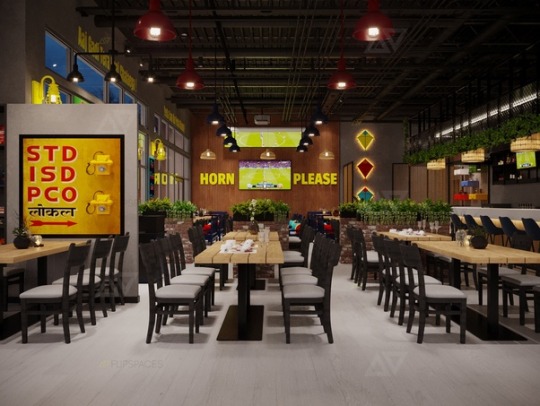
Setting the Stage
Imagine entering a restaurant and immediately feeling like you've stepped into a different time, place, or even universe. The interior design is the first thing that sets the stage for the dining experience. Whether it's a rustic farmhouse, a vibrant tropical paradise, or a mystical fairy-tale forest, the décor should instantly transport guests to the theme's world.
Consistency is Key
For theme restaurants, consistency is crucial. Every element of the interior design, from the furniture to the lighting, should align with the chosen theme. A hodgepodge of mismatched elements can break the illusion and diminish the overall experience.
Attention to Detail
The magic of a theme restaurant often lies in the details. Paying close attention to every aspect of the décor can make all the difference. Custom-made fixtures, unique wall art, and thematic table settings are just a few ways to enhance the atmosphere and immerse guests in the theme.
Lighting Sets the Mood
Lighting plays a pivotal role in creating the right ambiance. Soft, warm lighting can make a medieval castle-themed restaurant feel cozy and inviting, while neon lights can add a futuristic touch to a sci-fi-themed eatery. Experiment with different lighting techniques to achieve the desired mood.
Comfort and Functionality
While aesthetics are essential, comfort and functionality should not be compromised. Uncomfortable seating, impractical table arrangements, or a lack of essential amenities can mar the dining experience, no matter how captivating the theme is.
Interactive Elements
To take the immersive experience a step further, consider incorporating interactive elements into the restaurant's interior. For example, a pirate-themed restaurant might have hidden treasure chests, while a space-themed eatery could feature an interactive control panel at each table. These elements engage diners and make the theme come alive.
Soundscapes and Music
Sound is a powerful tool for enhancing the theme. Background music and ambient sounds should complement the restaurant's atmosphere. In a rainforest-themed restaurant, the gentle patter of rain and chirping birds can transport guests to the heart of the jungle.
Staff Uniforms
The restaurant's theme should extend to the staff's uniforms. When waitstaff and other employees are dressed in attire that matches the restaurant's concept, it reinforces the immersive experience for guests.
Flexibility for Evolving Themes
As trends and customer preferences change, it's essential to design the restaurant's interior with some flexibility. Elements that can be easily updated or modified allow theme restaurants to adapt and stay relevant over time.
Safety and Accessibility
Lastly, safety and accessibility should never be overlooked. Ensure that the interior design complies with all safety regulations and provides easy access for all patrons, including those with disabilities.
Conclusion
Designing the interior of a restaurant chain requires careful planning and consideration. It's an opportunity to express your brand's identity, create a memorable dining experience, and ensure consistency across multiple locations. By paying attention to key elements like brand identity, layout, lighting, furniture, color palette, décor, music, and sustainability, you can create an inviting and cohesive restaurant interior that keeps customers coming back for more. Remember, the interior of your restaurant is an integral part of your brand story, so make it count. One can achieve this by getting in touch with renowned design and build firms such as Flipspaces, which can help you with the same.
0 notes
Text
How can modern hotel designs create unique and immersive guest experiences that set them apart from competitors?
Title: Elevating Hospitality: How Modern Hotel Designs Create Unique and Immersive Guest Experiences
Introduction
In today's hyper-competitive hospitality industry, hotels are constantly seeking innovative ways to differentiate themselves and offer guests unforgettable experiences. One of the key strategies for achieving this is through modern hotel designs that go beyond the traditional concept of a place to stay, transforming hotels into immersive destinations in themselves. In this blog, we'll explore how modern hotel designs can create unique and immersive guest experiences that set them apart from competitors.
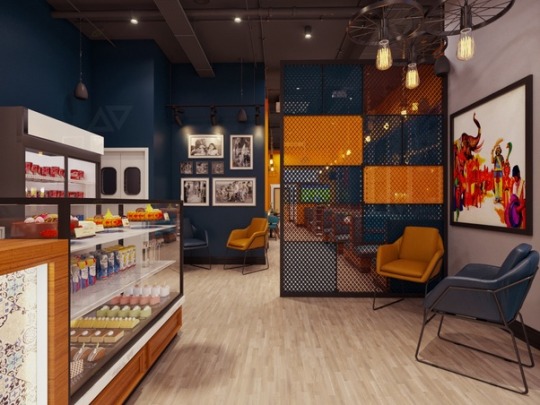
Guest-Centric Design
Modern hotel designs prioritize guest needs and preferences. They focus on creating spaces that seamlessly blend aesthetics and functionality, making guests feel both comfortable and inspired. This guest-centric approach often involves:
a. Personalized Spaces: Customized rooms and suites that cater to different guest segments, whether it's families, solo travelers, or couples. These spaces can include unique layouts, thematic décor, and personalized amenities.
b. Multi-Functional Spaces: Hotels incorporate versatile areas that can serve multiple purposes. For example, a lobby can double as a co-working space during the day and a social gathering spot at night.
c. Smart Technology: Integration of smart technology, such as in-room tablets or mobile apps, to control lighting, temperature, and entertainment systems. This not only adds convenience but also enhances the overall guest experience.
Aesthetic Innovation
In the quest to create immersive experiences, modern hotel designs often push the boundaries of aesthetics. Some design elements include:
a. Art and Culture: Incorporating local art and cultural elements into the hotel's design can provide a sense of place. Guests can immerse themselves in the local culture without leaving the property.
b. Sustainable Design: Many modern hotels emphasize sustainability through eco-friendly materials and energy-efficient systems. Sustainable design not only benefits the environment but also appeals to eco-conscious travelers.
c. Signature Style: Establishing a distinctive design style or theme can set a hotel apart. For example, a boutique hotel might adopt a vintage, retro vibe, while a luxury resort might opt for a sleek, contemporary look.
Unique Amenities
To stand out in a crowded marketplace, modern hotels offer unique amenities that elevate the guest experience. These may include:
a. Rooftop Bars and Pools: Offering breathtaking views and a vibrant social scene, rooftop bars and pools create memorable moments for guests.
b. Spa and Wellness Facilities: High-quality spas, fitness centers, and wellness programs cater to guests seeking relaxation and rejuvenation during their stay.
c. Culinary Experiences: World-class dining options, including in-house restaurants led by renowned chefs, cooking classes, and immersive food and beverage events, are increasingly common in modern hotels.
Technology Integration
Incorporating technology seamlessly into the guest experience is essential in modern hotel designs. This can involve:
a. Contactless Check-In/Check-Out: Streamlining the arrival and departure process through mobile check-in and keyless entry systems.
b. Virtual Concierge: Offering virtual concierge services through chatbots or apps, providing guests with instant assistance and recommendations.
c. Augmented Reality (AR) and Virtual Reality (VR): Using AR and VR to enhance guest experiences, such as virtual tours of local attractions or immersive in-room entertainment.
Conclusion
Modern hotel designs are revolutionizing the hospitality industry by creating unique and immersive guest experiences that set them apart from competitors. Through guest-centric design, aesthetic innovation, unique amenities, and technology integration, hotels are transforming themselves into destinations where every guest interaction is an opportunity for memorable moments. As travelers increasingly seek authentic and immersive experiences, hotels that embrace these design principles will continue to thrive in the ever-evolving world of hospitality. You can get your next modern hotel design designed and built by a tech-led interior design company such as Flipspaces which can be your one-stop solution to all your turnkey needs.
1 note
·
View note
Text
Creating a Timeless Look: What are the classic elements of restaurant wall design?
In the ever-evolving world of restaurant design, some elements never go out of style. Timeless restaurant wall design combines classic elements that evoke elegance, sophistication, and enduring appeal. In this blog, we'll explore the key elements that contribute to a timeless look in restaurant wall design.
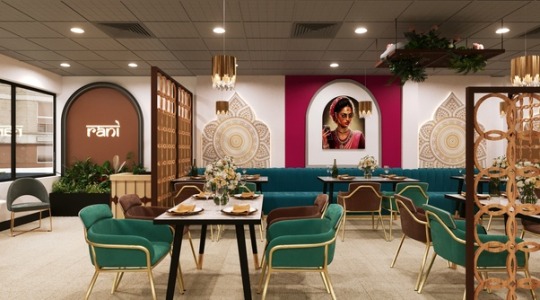
Neutral Color Palettes: A neutral color palette is a hallmark of timeless design. Colors like white, beige, gray, and taupe create a clean and versatile backdrop for restaurant walls. Neutral tones allow other design elements, such as furniture and decor, to shine and can adapt to changing trends without losing their charm.
Elegant Wainscoting: Wainscoting is a classic wall treatment that adds a touch of refinement and structure to restaurant walls. Whether it's breadboard, raised panels, or picture frame molding, wainscoting can be painted in a contrasting color or kept in a neutral tone to create a sense of sophistication.
Crown Molding: Crown molding is an elegant architectural detail that enhances the visual appeal of restaurant walls. It adds depth and character while creating a polished and finished look. Traditional crown molding designs are particularly timeless.
Fine Art and Framed Prints: Incorporating fine art and framed prints on restaurant walls is a timeless way to add personality and style. Classic art pieces or antique prints in ornate frames can create a sense of history and culture that transcends trends.
Woven Textiles: Textured wall coverings made of natural materials like grass cloth, wicker, or bamboo are classic choices. These textured materials add depth and warmth to restaurant walls while maintaining a timeless and rustic elegance.
Vintage Accents: Antique-inspired décor elements, such as vintage mirrors, ornate sconces, or retro signage, can add a sense of nostalgia and timeless charm to restaurant walls. These accents create a sense of history and character.
Subtle Patterns: Classic patterns like stripes, damask, herringbone, or toile can be incorporated into restaurant wall design for a timeless touch. Subtle patterns can be achieved through wallpaper, upholstery, or decorative molding.
Wood Paneling: Wood paneling is a timeless choice for restaurant walls. Whether it's traditional raised paneling, breadboard, or shiplap, wood adds warmth and texture. It can be stained to showcase the natural beauty of the wood or painted to match the restaurant's color scheme.
Symmetry and Balance: Timeless restaurant wall design often incorporates symmetry and balance. Evenly-spaced wall décor, symmetrical layouts, and well-proportioned architectural elements create a sense of order and harmony that stands the test of time.
Quality Materials: Using high-quality materials is essential for achieving a timeless look. Invest in durable and authentic materials like solid wood, real stone, or genuine textiles. Quality materials not only enhance aesthetics but also ensure longevity.
Classic Lighting Fixtures: Timeless lighting fixtures include crystal chandeliers, elegant wall sconces, and traditional pendant lights. These fixtures add a touch of glamour and sophistication to restaurant walls.
Custom Millwork: Custom millwork, such as built-in shelving, cabinetry, and paneling, can be tailored to the restaurant's unique needs. Custom designs ensure that the restaurant walls are both functional and aesthetically pleasing.
In conclusion, a timeless look in restaurant wall design relies on classic elements that withstand the test of time. By incorporating neutral color palettes, architectural details like wainscoting and crown molding, vintage accents, and quality materials, you can create a restaurant atmosphere that exudes elegance and sophistication. A timeless design not only appeals to a broad audience but also ensures that your restaurant remains inviting and appealing for years to come. One can achieve this by getting in touch with renowned design and build firms such as Flipspaces, who can help you with the same.
0 notes
Text
What is the restaurant wall design for small spaces maximizing impact?
Designing a restaurant, particularly in small spaces, presents a unique set of challenges. The key is to create an ambiance that feels inviting and comfortable while making the most of the limited square footage. Restaurant wall design plays a crucial role in achieving this balance. In this blog, we'll explore how to maximize the impact of wall design in small restaurant spaces.

Use of Mirrors: Mirrors are a powerful tool for visually expanding small spaces. Strategically placed mirrors can make the restaurant feel larger and more open. Consider using mirrored wall panels or a large decorative mirror as a focal point on one of the walls. Mirrors also reflect light, which can brighten up the space and make it feel more welcoming.
Vertical Wall Gardens: Vertical wall gardens or living walls, are a fantastic way to infuse greenery and life into small restaurant spaces. They not only add visual interest but also create a sense of depth and vibrancy. Vertical gardens can be incorporated as entire walls or as smaller sections, depending on the available space.
Neutral Color Palette: Choosing a neutral color palette for restaurant walls in small spaces can create a sense of airiness and continuity. Light colors like whites, creams, and soft grays can make the space feel more open and less cluttered. Consider using different shades of the same color for added depth without overwhelming the senses.
Multi-Functional Walls: In small restaurant spaces, every square inch matters. Design walls that serve multiple functions. For example, wall-mounted shelves can not only display decorative items but also serve as storage for glassware, dishes, or wine bottles. This maximizes both aesthetics and practicality.
Wall Art and Decorative Features: Selecting the right wall art and decorative features can make a significant impact. opt for pieces that complement the restaurant's theme and ambiance. Large, eye-catching artworks or a gallery wall of smaller pieces can draw attention away from the size of the space and add character.
Texture and Patterns: Incorporating texture and patterns on restaurant walls can create visual interest. Textured wall coverings like grass cloth, bamboo, or embossed wallpaper can add depth without taking up physical space. Similarly, patterns, whether geometric or organic, can make a small space feel more dynamic and lively.
Custom Wall-Mounted Furniture: Consider custom-designed wall-mounted furniture pieces that can serve as both functional and decorative elements. Wall-mounted banquettes or bench seating, for example, can maximize seating capacity while adding a unique design element to the space.
Strategic Lighting: Lighting design is critical in small restaurant spaces. Wall-mounted sconces, pendant lights, or wall-washing fixtures can create a warm and inviting atmosphere. Proper lighting also enhances the perception of space and adds to the overall ambiance.
Open Shelving: Open shelving is a practical and stylish way to utilize wall space in small restaurants. Use open shelves to display decor, glassware, or even menu items. This not only adds personality to the space but also frees up floor space that would otherwise be occupied by cabinets or storage units.
Space-Saving Design: Lastly, invest in space-saving furniture and design elements. Wall-mounted tables, foldable chairs, and compact furnishings can help maximize seating capacity while ensuring that the space remains functional and uncluttered.
In conclusion, restaurant wall design in small spaces requires thoughtful planning and creativity. By incorporating mirrors, vertical gardens, neutral colors, multi-functional elements, and a strategic use of lighting, you can create an inviting and visually appealing dining environment. Remember that small spaces can have a cozy and intimate charm that larger restaurants may lack, making them equally appealing to diners seeking an intimate and memorable experience. One can achieve this by getting in touch with renowned design and build firms such as Flipspaces, who can help you with the same.
0 notes